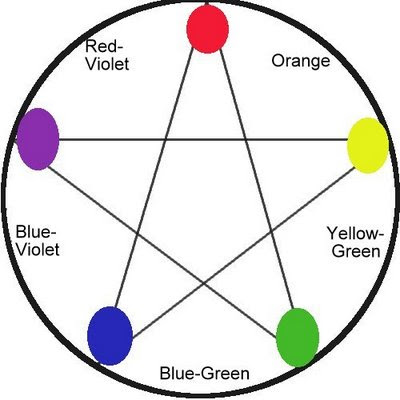
It was Sir Isaac Newton who in 1666 invented what came to be known as the triadic color wheel built on three primary colors--yellow, red and blue.
But in 1898, Albert Munsell came up with a totally new color system, one built on what he called five primaries--yellow, red, violet, blue and green. (See wheel on at top.)
We can use the Munsell color wheel to put together color schemes discussed in last week's tutorial, but with slightly different results. For example, the complement of yellow according to Munsell is blue-violet, the complement of red is blue-green, but orange remains the complement of blue. Munsell's system gives a shorter range between red and yellow than our primary triad does. Whereas the triadic wheel yield 12 colors, then, Munsell has only 10.
Actually, Munsell's arrangement on the wheel is closer to how our eyes perceive color. Try this: find a bright red sheet of paper. Stare at it for 15 seconds, then suddenly shift your eyes to a white surface and hold for 3 or 4 seconds. An afterimage will appear that is actually blue-green rather than pure green.
In fact, Munsell's system is not actually built on a wheel, but rather a sphere that shows the interconnectedness of hue, value and intensity. Our triad wheel is based on hue alone.
To understand Munsell, imagine a globe with all the colors on the surface of its equator circling like colors positioned in a spectrum. Here the are the brightest, purest possible hues. Then imagine all these same colors gradually getting lighter as they migrate upward to the north pole and likewise, gradually getting darker as they move downward to the south pole. Here's what the outside of Munsell's sphere looks like.
But there's more. The inside of the sphere toward its core illustrate how neutrals are formed. Imagine a slice across the center of the globe starting at green and ending at red-violet. Now imagine what's happening on that slice if on the green side a little bit of red-violet is added just inside the edge, then a little more as it moves toward the core, continuing until it reaches the core where it becomes totally neutral. On the red-violet side, the same thing is happening by adding a little bit of green at a time. That cross section would look something like this image I borrowed from Encyclopedia Britannica:
Inside the sphere color values get lighter as the rise to the top and darker toward the bottom. That's pretty much what the Munsell system looks like
In my mind, the Munsell system is scientific attempt to illustrate the workings of color whereas the triadic wheel is a thinking tool. There is no doubt that within the Munsell system, you could locate any color there is. It's somewhere in there, believe me. And it's fun to try to do that. In fact, it's a good way to understand the true nature of color.
But for my money, the triadic wheel is a better tool for thinking, leaving us more freedom for working out color mixtures.
You can get a more detailed explanation of the Munsell System by going HERE and for more references, go HERE.


4 comments:
A very well handled look at Munsell, Diane.
I agree that it is a slow turning wheel when it comes to thinking about color, though.
Not to be a smarty pants, but I am also starting to like Leonardo's straight line color theory - it looks more like my palette! Just another way to look at it.
Thanks for writing Compose!
Dianne, I'm so enjoying your blog and the vast amount of sharing that you do with your extensive art knowledge. Your work is beautiful.
Dianne, thaks for this blog! Im fiNding it very informative ..and interesting! I studied Munsells concept yearwws aago and at that time thought it way to ahrd to understand ... BUT I LOVE turquiose and red together and now know why!!!
Thanks for your efforts on COMPOSE!
Thanks for this post! Previous to this I always used Netwton's color wheel to determine complementry colors when designing a web site. Munsell's concept of placing colors on a shpere instead of a wheel is very interesting.
Post a Comment